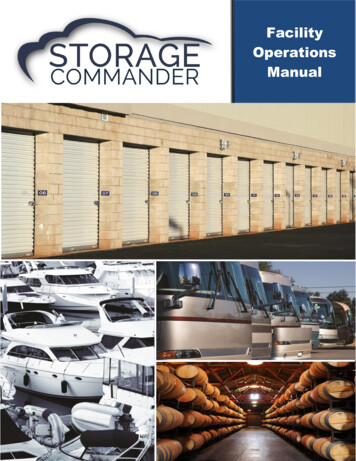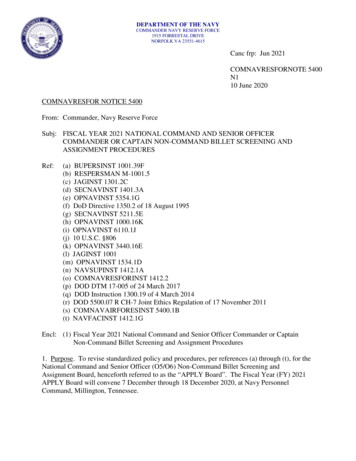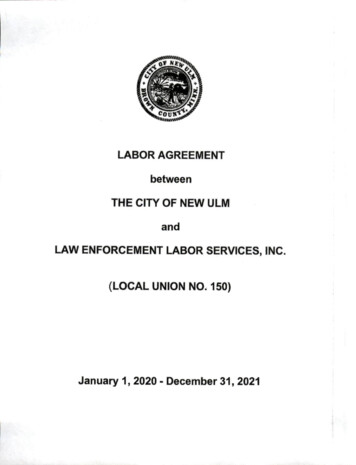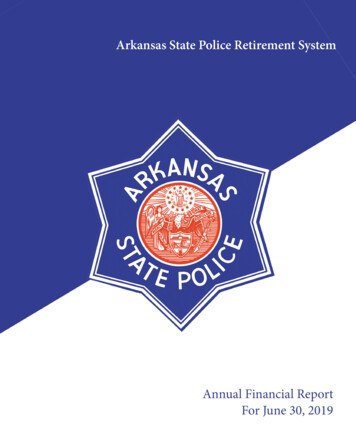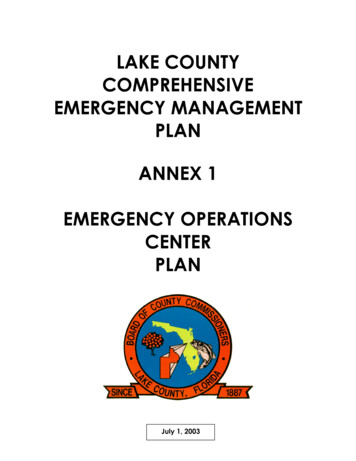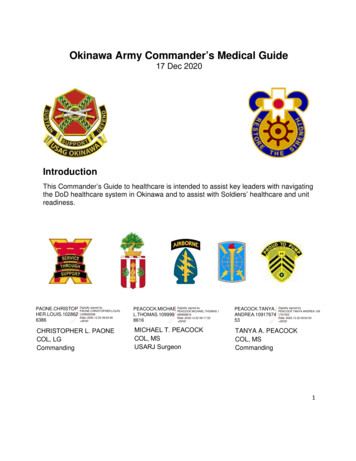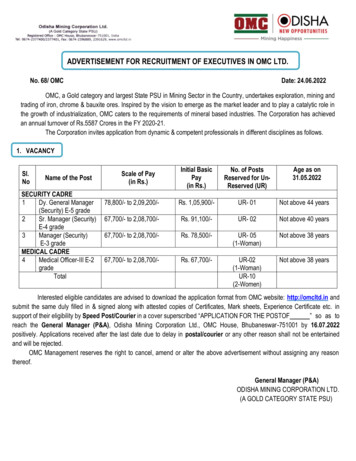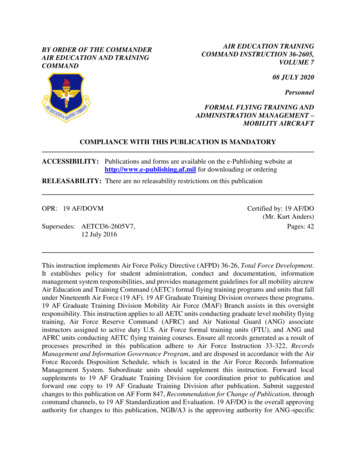
Transcription
BY ORDER OF THE COMMANDERAIR EDUCATION AND TRAININGCOMMANDAIR EDUCATION TRAININGCOMMAND INSTRUCTION 36-2605,VOLUME 708 JULY 2020PersonnelFORMAL FLYING TRAINING ANDADMINISTRATION MANAGEMENT –MOBILITY AIRCRAFTCOMPLIANCE WITH THIS PUBLICATION IS MANDATORYACCESSIBILITY: Publications and forms are available on the e-Publishing website athttp://www.e-publishing.af.mil for downloading or orderingRELEASABILITY: There are no releasability restrictions on this publicationOPR: 19 AF/DOVMSupersedes: AETCI36-2605V7,12 July 2016Certified by: 19 AF/DO(Mr. Kurt Anders)Pages: 42This instruction implements Air Force Policy Directive (AFPD) 36-26, Total Force Development.It establishes policy for student administration, conduct and documentation, informationmanagement system responsibilities, and provides management guidelines for all mobility aircrewAir Education and Training Command (AETC) formal flying training programs and units that fallunder Nineteenth Air Force (19 AF). 19 AF Graduate Training Division oversees these programs.19 AF Graduate Training Division Mobility Air Force (MAF) Branch assists in this oversightresponsibility. This instruction applies to all AETC units conducting graduate level mobility flyingtraining, Air Force Reserve Command (AFRC) and Air National Guard (ANG) associateinstructors assigned to active duty U.S. Air Force formal training units (FTU), and ANG andAFRC units conducting AETC flying training courses. Ensure all records generated as a result ofprocesses prescribed in this publication adhere to Air Force Instruction 33-322, RecordsManagement and Information Governance Program, and are disposed in accordance with the AirForce Records Disposition Schedule, which is located in the Air Force Records InformationManagement System. Subordinate units should supplement this instruction. Forward localsupplements to 19 AF Graduate Training Division for coordination prior to publication andforward one copy to 19 AF Graduate Training Division after publication. Submit suggestedchanges to this publication on AF Form 847, Recommendation for Change of Publication, throughcommand channels, to 19 AF Standardization and Evaluation. 19 AF/DO is the overall approvingauthority for changes to this publication, NGB/A3 is the approving authority for ANG-specific
2AETCI36-2605V7 08 JULY 2020changes, and AFRC/A3 is the approving authority for AFRC-specific changes. The authorities towaive wing/unit level requirements in this publication are identified with a Tier (“T-0, T-1, T-2,T-3”) number following the compliance statement. See Air Force Instruction (AFI) 33-360,Publications and Forms Management, for a description of the authorities associated with the Tiernumbers. Direct all questions concerning this instruction to 19 AF Graduate Training DivisionMAF Branch at 19AF.Operations.SupportMAF@us.af.mil. This publication requires collectingor maintaining information protected by the Privacy Act of 1974. The authorities to collect and ormaintain the records prescribed in this publication are Title 37, United States Code, Section 301a,Special and Incentive Pays, and Executive Order 9397 which authorizes collection of socialsecurity numbers. Privacy Act system of records notice F011 AF XO A, Aviation ResourceManagement System (ARMS), F036 AF AETC B, Graduate Training Integration ManagementSystem (GTIMS) and F036 AETC Y, Training Integration Management System (TIMS) Records,applies and is available on line at MMARY OF CHANGESThis document has been substantially revised and must be completely reviewed. Majorchanges include: tiered waiver guidance in accordance with AFI 33-360; updated references to 19AF office symbols and appropriate organizations; clarified responsibilities and delegationauthorities; updated syllabus waiver routing and delegation authorities; updated student recallprocedures; updated web links, references, abbreviations, acronyms, and terms.Chapter 1—GENERAL GUIDANCE51.1.Introduction. .51.2.Specific Use. .51.3.Responsibilities. .51.4.Training Syllabus. .91.5.Equipment Required. .91.6.End-of-Course Critiques. .91.7.Aircrew Graduate Evaluation Program (AGEP). .91.8.Production Metrics Report. .10Chapter 2—STUDENT ADMINISTRATION112.1.Inprocessing. .112.2.Waivers. .112.3.Syllabus Variations. .122.4.Notification Procedures. .132.5.Fitness Standards. .14
AETCI36-2605V7 08 JULY 202032.6.Student Scheduling. .142.7.Training Requirements and Restrictions. .142.8.Distinguished Graduate (DG). .14Chapter 3—TRAINING MANAGEMENT153.1.Training records. .153.2.Grading Procedures. .16Table 3.1.Task/Event or Lesson/Sortie Performance Standard. .16Table 3.2.Task/Event or Lesson/Sortie Knowledge Standard. .17Table 3.3.Individual Task/Event Grading Scale. (Units not using GTIMS). .18Table 3.4.Overall Lesson/Sortie Grading Scale. (Units not using GTIMS) .183.3.Units Employing GTIMS Grading Procedures. .19Table 3.5.Task/Event Performance Standards for GTIMS. .19Table 3.6.Overall Lesson/Sortie Grade and Description for GTIMS. .20Table 3.7.Overall Status and Definition.213.4.Course Training Standards (CTS). .213.5.Maneuver Item File (MIF). .223.6.Duties and Responsibilities. .223.7.Regression Rules. .223.8.Proficiency Advancement (PA). .223.9.Break-in-Training (BIT). .223.10.Additional Training (AT). .223.11.Disposition of Student Training Records. .233.12.Academic Examinations for International Students. .23Chapter 4—STUDENT MANAGEMENT244.1.Commander’s Awareness Program (CAP). .244.2.Progress Review Process (PR). .254.3.Elimination Check (EC). .264.4.Commander’s Review (CR) Process. .264.5.CR Records Distribution. .27
4AETCI36-2605V7 08 JULY 2020Table 4.1.Distribution of Initial CEA CR Records. .274.6.Student Eliminations. .284.7.Student Dispositions. .29Chapter 5—MEDICAL MANAGEMENT REQUIREMENTS305.1.General. .305.2.Airsickness. .305.3.Manifestation of Apprehension (MOA). .305.4.Administrative Hold Status. .305.5.Administrative Requirements for Flying Training Supervisors and FlightSurgeons.30Attachment 1—GLOSSARY OF REFERENCES AND SUPPORTING INFORMATION32Attachment 2—SAMPLE STUDENT NOTIFICATION MEMORANDUM39Attachment 3—BRIEFING GUIDE AND CHECKLIST FOR THE CR PROCESS40Attachment 4—OVERVIEW OF COMMANDER’S REVIEW PROCESS42
AETCI36-2605V7 08 JULY 20205Chapter 1GENERAL GUIDANCEThis instruction complements AETCI 36-2605, Volume 1, Formal Flying TrainingAdministration and Management1.1. Introduction. 19 AF conducts graduate level flying training courses to provide qualifiedaircrew to the mobility air forces (MAF) and to sustain FTU operations. These training coursesproduce aircrew with basic, mission, instructor, and special qualifications applicable to eachaircraft and mission. Each flying training course syllabus outlines graduation status, traininglocation, course entry prerequisites, and provides a summary of training. The Education andTraining Course Announcements (ETCA) Website, ome.aspx also provides student administration and processing information.1.2. Specific Use.1.2.1. Applies to all mobility graduate level students, officers and career enlisted aviators(CEA).1.2.2. For the purposes of this instruction, there are two categories of CEAs enrolled ingraduate level flying training, initial and qualified/previously qualified.1.2.2.1. Initial CEA. Students that have not successfully completed an aircraft missionqualification evaluation. Initial CEA students enrolled in formal flight training (FFT) arein conditional aviation career status.1.2.2.2. Qualified/Previously Qualified CEA. Students who have completed FFT (i.e.,have received a mission qualification in-flight evaluation with an AF Form 8, Certificateof Aircrew Qualification, AF Form 8a, Certificate of Aircrew Qualification (MultipleAircraft), or AF Form 942, Record of Evaluation on file). Qualified CEA students enrolledin FFT are considered qualified for aviation service and are subject to review according toAFMAN 11-402, Aviation and Parachutist Service, when conduct or duty performancebecomes suspect.1.3. Responsibilities.1.3.1. 19 AF Commander (19 AF/CC). 19 AF/CC is responsible for executing formal flyingtraining operations within AETC. 19 AF/CC is the approval authority for removing a studentfrom training for cause.1.3.1.1. The respective subordinate commander will make a recommendation to 19 AF/CCfor consideration.1.3.1.2. For cause includes students engaging in misconduct punishable under the UniformCode of Military Justice, or a student who demonstrates improper conduct, attitude, or lackof responsibility toward assigned duties or obligations. This may include characterdisorders that raise doubt about the student’s fitness for continued service.1.3.1.3. Wing commanders (WG/CC) should contact 19 AF Staff Judge Advocate (19AF/JA) and 19 AF Director of Operations (19 AF/DO) for guidance in specific situations.
6AETCI36-2605V7 08 JULY 20201.3.2. 19 AF Director of Operations (19 AF/DO). 19 AF/DO establishes policies andprovides directives and resources for the conduct of mobility aircrew training in AETC toinclude formal course training conducted by ANG and AFRC FTUs. In addition, 19 AF DOcertifies formal flying training syllabi developed and maintained by AETC.1.3.3. 19 AF Graduate Training Division:1.3.3.1. Oversees execution of aircrew training, administration, and management withinAETC. The NGB/A3 and AFRC/A3 oversee aircrew training, administration, andmanagement for ANG and AFRC FTUs respectively.1.3.3.2. Coordinates graduate flying training policies.1.3.3.3. Oversees syllabus development and AETC, AFRC, ANG and InternationalMilitary Student (IMS) graduate level flying training courseware management.1.3.3.4. Coordinates student recalls to their units before the student disenrolls or departsaccording to AFMAN 11-202V1, Aircrew Training, and notifies 19 AF GraduateResources and Analysis Division of all student recalls.1.3.3.5. Approve waivers according to paragraph 2.2.1.3.4. 19 AF Graduate Resources and Analysis Division. 19 AF Graduate Resources andAnalysis Division oversees programmed flying training (PFT) programming and management.The PFT document establishes the baseline for student quota management, which is AETC’saircrew training primary source document for class entry dates, student load, and productionschedule information. They maintain the quota management worksheets, available athttps://cs2.eis.af.mil/sites/12732/default.aspx. Note: AETC provides class quotas annuallyvia electronic PFT pages.1.3.5. 19 AF Flying Training Resource Analysis. 19 AF Flying Training Resource Analysisoversees production metrics reporting. At the beginning of each fiscal year, uploads the PFTdocument to the Flying Training Production Analysis - Web (FTPA-W) web-based input tool.1.3.6. Wing Commander (WG/CC). WG/CC is responsible for waiving additional sortiesabove those outlined in the syllabus. Approves/Disapproves waivers according to paragraph2.2.3.3.1.3.7. Operations Group Commander (OG/CC). OG/CC is responsible for formal coursetraining according to AETCI 36-2605V1 (T-3). The OG/CC:1.3.7.1. Executes formal course training as directed by the appropriate syllabi and thisinstruction (T-3).1.3.7.2. Identifies to the appropriate agency limiting factors and shortfalls that preventsuccessful mission accomplishment (T-3).1.3.7.3. Ensures students meet course entry requirements (T-3). If a student does not meetcourse entry prerequisites, an approved prerequisite entry waiver is required prior to theclass start date. (T-2). See Chapter 2 for process information.1.3.7.4. Appoints contracting officer representatives (COR) to ensure Aircrew TrainingSystem (ATS) contractors meet standards (T-2). COR duties and responsibilities can be
AETCI36-2605V7 08 JULY 20207found on the Defense Acquisition University web site under Acquisition CommunityConnection at https://acc.dau.mil/COR.1.3.7.5. Assigns an ATS program manager, course manager, or subject matter expert foreach crew position in each mission design series (MDS) (T-2). On the Defense AcquisitionUniversity website, the Roles and Responsibilities of Participants document describes howthis individual assists the COR in validating contract requirements.1.3.7.6. Tracks all syllabus deviations and immediately notifies 19 AF Graduate TrainingDivision MAF Branch (T-3). Note: For ANG or AFRC FTUs co-located with active dutyFTUs, one unit may handle these requirements for both FTUs. OG/CCs sharing trainingresources have shared responsibility for these items and may delineate certainresponsibilities between groups in local guidance or memorandums of understanding.1.3.8. Squadron Commander (SQ/CC). SQ/CC executes formal training according to theAETC syllabi (T-3). The SQ/CC:1.3.8.1. Organizes student administration under a designated flight or section (T-3).(Example, flight commander (FLT/CC) or designated representative for students.)1.3.8.2. Administers the commander’s awareness program (CAP) according to Chapter 4(T-3). CAP administration may be delegated, but the SQ/CC maintains overall authorityand responsibility (T-3).1.3.8.3. Notifies the OG/CC or designated representative as soon as possible after asyllabus deviation (T-3).1.3.8.4. Assigns students awaiting training (medical or administrative hold, etc.) to dutiescommensurate with their background, training, and grade (T-3).1.3.8.5. Notifies 19 AF Graduate Training Division MAF Branch of students whosetraining has been suspended more than 14 calendar days (T-3).1.3.8.6. Ensures students do not receive more than eight hours of testable classroom andcomputer-assisted instruction of academic subjects per day (T-3). Examinations areconsidered testable material.1.3.9. Registrar. The registrar manages student accounting actions from arrival, throughtraining and departure (T-2). The registrar:1.3.9.1. Obtains class entry rosters in the military personnel data system (MilPDS) notlater than 30 days before class entry (T-3). Units without access to MilPDS will forward acomplete class roster to 19 AF within 10 duty days of scheduled class arrival (T-3).1.3.9.1.1. Obtain rosters as early as possible to identify excess capacity (T-3).1.3.9.1.2. Contact 19 AF Graduate Resources and Analysis Division, AFPC/DP2LTand AFPC/DP2ORM to allow fill of excess capacity (T-3).1.3.9.2. Manages, coordinates, processes and tracks AETC Forms 6, Waiver Request, forcourse prerequisite waivers, syllabus waivers and overages until final disposition (T-3).1.3.9.2.1. Ensure prerequisite waivers have been submitted for all students requiringthem (T-3).
8AETCI36-2605V7 08 JULY 20201.3.9.2.2. Students who arrive without required course prerequisites may be returned,in coordination with 19 AF Graduate Training Division MAF Branch and 19 AFGraduate Resources and Analysis Division, to their parent organization/base to obtainprerequisites.1.3.9.3. Accomplishes an inprocessing checklist for all students (T-3).1.3.9.4. Loads student data into the appropriate training management system (TMS) and/orLearning Management System (T-3).1.3.9.5. Ensures students are registered in the correct course, inputs into the correctelectronic training record/TMS or ensures hardcopies are prepared and distributed. (T-3).Refer to AETCI 36-2605V1 for AETC-required student data into TIMS/GTIMS.1.3.9.6. Immediately notifies 19 AF/DO, 19 AF Graduate Training Division and thestudent’s parent MAJCOM/A3T, if a student’s home unit attempts to recall the student (T3).1.3.9.7. [Active Duty Units] Reports roster discrepancies as soon as they are discovered,but no later than 3 duty days following class start date (T-3). Report changes, discrepancies,and graduation delays to 19 AF Graduate Training Division, 19 AF Graduate Resourcesand Analysis Division, 19 AF Flying Training Resource Analysis, AFPC/DP2LT,AFPC/DP2ORC, and AFRC/A1KE, or NGB/A3O as applicable (T-3).1.3.9.8. [ANG FTUs] Reports roster discrepancies as soon as they are discovered, but nolater than 3 duty days following the class start date (T-3). Report changes, discrepancies,and graduation delays to 19 AF Graduate Resources and Analysis Division, 19 AFGraduate Training Division MAF Branch and NGB/A3O (T-3).1.3.9.9. Ensures a complete and accurate entry roster of enrolled students is submitted tothe appropriate Force Support Squadron or servicing military personnel unit not later than10 duty days before the class start date. (T-3).1.3.9.9.1. Before the student departs, the home unit will prepare an AF Form 63, ActiveDuty Service Commitment (ADSC) Acknowledgement Statement, according to AFI 362107, Active Duty Service Commitments (ADSC).1.3.9.9.2. The servicing Military Personnel Flight will determine the existence andaccuracy of each student’s AF Form 63 (T-3).1.3.9.10. Reports changes or discrepancies to 19 AF Graduate Resources and AnalysisDivision and for ANG FTUs to NGB/A3O (T-3). With ANG approval, students awaitingtraining may be entered in an earlier class.1.3.9.11. Ensures all inputs are made to MilPDS no later than 3 duty days after the classstart date (T-3).1.3.9.12. Updates MilPDS no later than 3 duty days after class graduation date (T-3).1.3.9.13. Immediately notifies the host aviation resource management (HARM) officewhen any student is removed from training (T-2). Refer to AFMAN 11-402.1.3.9.14. Maintains original records according to the RDS and distributes them within 10duty days of completion of a student’s training review (T-3).
AETCI36-2605V7 08 JULY 202091.3.9.15. Distributes records of eliminated initial CEAs as outlined in Table 4.1 (T-2). Forofficers and qualified CEAs, distributes records according to AFMAN 11-402.1.3.9.16. Updates eliminations in the appropriate training management database with theproper elimination code (T-2).1.4. Training Syllabus. The syllabus is the command-approved directive for executing each PFTformal training course. It takes precedence over local instructions and supplements. If no clearsyllabus guidance exists, resolve the conflict using the appropriate chain of command (T-3). Onlythe office of primary responsibility (OPR) may interpret syllabus guidance (T-2). If the logicalcourse of action conflicts with other directives, call the OPR listed in the syllabus. AETC syllabiare not valid until signed by 19 AF/DO and will not be implemented until a signature is obtained(T-2). Note: If a conflict exists between the syllabus and a supporting ATS contract, the originalAETC approved syllabus in place at that time will continue to be executed until the conflict isresolved by AETC, Air Mobility Command (AMC), and Air Force Material Command (T-2).1.4.1. Course Durations. The syllabus lists the formal course training days, the PFT listscourse planned start and graduation dates. See Joint Travel Regulations, Uniformed ServiceMembers and DoD Civilian Employees, for temporary duty (TDY) time limitations forinstruction courses (Section 2240).1.4.2. Sortie and Hour Requirements. Each syllabus has a programmed number of sorties,flying hours and additional sortie authorizations. Unless otherwise specified in the syllabus,additional sorties required beyond the course limit must have 19 AF Graduate TrainingDivision approval (T-2). (For ANG students, NGB/A3 is the approval authority. AFRC/A3Mis approval authority for AFRC students.) Proficiency advancement is defined in paragraph3.8. It will not be used as a management tool to graduate students by a specific date (T-2).1.4.3. Academics. Units who maintain student written examinations will secure all tests anddocument the removal, replacement, and destruction of all examinations (T-3).1.5. Equipment Required. The FTU will provide equipment required to complete the specificcourse if that equipment has NOT been previously issued to the student during previous training(T-2). See specific course ETCA webpage at ome.aspx. Direct further questions regarding clothing, equipment, and specialrequirements to the school registrar or course contact listed on ETCA.1.6. End-of-Course Critiques. Each unit administers an end-of-course critique program as anintegral part of the formal training course (T-2). Supervisors review reports and initiate correctiveaction as necessary. Critiques will be administered within 15 duty days of graduation (T-3). Unitswill submit a summary of the end-of-course critiques to the AETC Program Managers/subjectmatter experts for review at least quarterly (T-3). Use AETC Form 673, Student Critiques, or anapproved local critique for written critiques (T-3). As a minimum, the critique will includequestions directly inquiring about unprofessional relationships, maltraining, maltreatment andothers as directed by 19 AF/CC (T-2). Wings will compile these answers and provide the studentresponses to the 19 AF/DO inbox quarterly (T-3).1.7. Aircrew Graduate Evaluation Program (AGEP). See AETCI 36-2206, Aircrew GraduateEvaluation Program.
10AETCI36-2605V7 08 JULY 20201.8. Production Metrics Report. 19 AF Flying Training Resource Analysis is the primary pointof contact (POC) for flying training production metrics. At the beginning of each fiscal year, 19AF Flying Training Resource Analysis uploads the PFT document to the FTPA Web-based inputtool. OG/CCs or their designated POCs will update FTPA with actual entries, gains, losses,eliminations, graduation numbers, and notes, if needed, to explain wash backs, eliminations, ordate changes to a class (T-3). Updates are due 5 calendar days after the class start date and classgraduation date. 19 AF Flying Training Resource Analysis will provide an end of year (by FY)student production summary by Mobility major weapon system and course to AMC/A3TF NLT90 days after the end of the fiscal year. 19 AF Graduate Resources and Analysis Division willprovide flying training production metrics to 19 AF/DO (19AF.MAF.Training@us.af.mil) uponrequest.
AETCI36-2605V7 08 JULY 202011Chapter 2STUDENT ADMINISTRATION2.1. Inprocessing. Units will review incoming student records to verify they are complete and todetermine initial supervision required before any other than “academic” only training courses. (T3). Students must meet course entry prerequisites established by the syllabus, AFMAN 11-202V1and AFI 11-2MDS, Volume 1 (T-2). They must also comply with reporting instructions in theETCA (T-2). At a minimum, units will review these records (or equivalents):2.1.1. Flight Evaluation Folder (FEF). Students will hand carry FEFs, if applicable, totraining according to ETCA guidance (T-3). Depending on the Air Force Specialty Code(AFSC), some individuals may not yet possess an FEF.2.1.2. Individual Flight Records. Students will hand carry flight records, if applicable, totraining according to ETCA guidance (T-3). Depending on AFSC, some individuals may notyet possess individual flight records.2.1.3. Training Records From Previous Courses. Enlisted Center of Excellence studentswill hand carry sealed training records to their follow-on training locations (T-3).2.2. Waivers.2.2.1. Prerequisite Waivers. Losing or home unit commanders will ensure students meetcourse entry prerequisites (T-3). Note: When an AFI/AFMAN prescribes formal course entryprerequisites, use that publication to determine waiver authority.2.2.1.1. IMS/DCS (Direct Commercial Sales) Waivers. The Air Force Security AssistanceTraining Squadron Commander (AFSAT/CC) will act in place of the losing or home unitcommanders when the waiver request applies to an IMS or DCS student. AFSAT ProgramManagers will work with AFSAT/MSR weapon system experts to initiate waivers. Thewaiver will be coordinated with AFSAT/DO before going to the AFSAT/CC. The waiverpackage will be loaded into Task Management Tool at the lowest possible level and willbe coordinated through AETC/IAO to 19 AF Graduate Training Division for finalapproval.2.2.1.2. Complete an AETC Form 6, for prerequisite waiver requests. (T-2).2.2.2. Syllabus Waivers. An approved syllabus waiver is required for any planned exceptionto AETC syllabi caused by special or unusual circumstances, for individual students (T-2). Donot accomplish, change the order of, or omit any training requested in a waiver until notifiedof approval (T-2). Permanent or blanket waivers are not authorized, but should be suggestedas individual syllabus changes through 19 AF Graduate Training Division MAF Branch (T-2).The WG/CC is the approval authority for daily syllabus execution waivers, delegated no lowerthan the SQ/CC (T-2). Submit individual waiver requests electronically on an AETC Form 6(T-2). Maintain a permanent record of all approved waivers in the student’s gradebook inGTIMS and attach a copy of the approved waiver to the 19 AF Graduate Training DivisionSharePoint at s/SitePages/Home.aspxNLT three days after approval.2.2.3. Approval Authorities. Submit waivers to these approval authorities, except whenother governing directives instruct otherwise.
12AETCI36-2605V7 08 JULY 20202.2.3.1. Syllabus Waivers and Syllabus Prerequisite Waivers. The losing/home units willinitiate waivers and coordinate through their local OG/CC (or equivalent) toMAJCOM/A3T (or equivalent) (T-2). MAJCOM/A3T (or equivalent) will forward to 19AF Graduate Training Division MAF Branch. 19 AF Graduate Training Division MAFBranch will coordinate with applicable FTU and will forward to 19 AF Graduate TrainingDivision for final approval.2.2.3.2. Senior Officer Syllabus and Entry Prerequisite Waivers. Route waivers throughMAJCOM/A3T (or equivalent) to 19 AF/DO (T-2).2.2.3.3. 19 AF/DO delegates authority to the FTU WG/CC to waive the following syllabusprerequisites: Physical Health Assessment (PHA) and/or Physiological Training (AltitudeChamber), with concurrence of the OG/CC and that the Medical Group commander willprovide these events by the appropriate time. This does not constitute authority to waiveflight-required events. Example: A student’s PHA expires 15 days after course completion;the WG/CC may waive the PHA syllabus prerequisite and allow the student to completetraining as sche
document to the Flying Training Production Analysis - Web (FTPA-W) web-based input tool. 1.3.6. Wing Commander (WG/CC). WG/CC is responsible for waiving additional sorties above those outlined in the syllabus. Approves/Disapproves waivers according to paragraph 2.2.3.3. 1.3.7. Operations Group Commander (OG/CC). OG/CC is responsible for formal .



